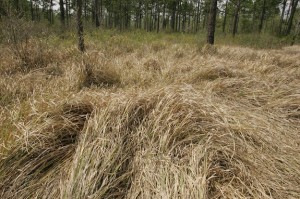Understanding native vs. non-native plants
 By Griff Johnson, Wildlife Biologist, Alabama Division of Wildlife and Freshwater Fisheries
By Griff Johnson, Wildlife Biologist, Alabama Division of Wildlife and Freshwater Fisheries
Habitat management is critical to sustaining Alabama’s wildlife populations. Most wildlife managers recognize this and work hard to make improvements to the land they manage. As they search for ways to improve the habitat, they discover numerous plants advertised to add value for wildlife. Some of those plants are native, but some are not. So, should a conscientious manager use native or exotic plants to improve wildlife habitat?
In past years, it was common to plant species such as bicolor lespedeza, sawtooth oak and autumn olive to enhance wildlife habitat potential. These particular species are all non-native plants. Bicolor lespedeza and autumn olive have proven to be invasive and pose a serious impact to Alabama’s native plant and animal communities. Sawtooth oak has exhibited the potential to become invasive and should be carefully monitored.
Many of the exotic plants found in Alabama were introduced into the state through the Port of Mobile. However, in attempting to use hardy plants that would help with erosion, human experimentation has helped invasive plants become established. For example, cogongrass was used as a cover plant to protect land from erosion and as a forage crop for cattle. Kudzu was introduced for erosion control, hay and forage capacity. Non-native plants have also been introduced into the landscape as ornamentals, such as the Bradford pear.
Alabama’s native plant species have natural adaptations to keep them in balance. The native plants and animals in Alabama’s natural setting have evolved and have developed checks to keep a single species from dominating the landscape.
In ornamental settings, exotic plants appear to be very attractive because they are resistant to native insects and diseases, a factor that helps them flourish. However, it is for the very same reason that non-native plants can become invasive when introduced into a wild landscape. One example, Chinese wisteria, can be controlled in an ornamental setting by pruning. If left alone, it will spread rapidly and establish itself outside the ornamental setting. This type of aggression allows this non-native plant to take over native plants and create a monoculture of wisteria. As it continues to grow and spread, it will shade all native groundcover surrounding the infestation, denying food-producing plants for wildlife.
The Alabama Invasive Plant Council(www.se-eppc.org/alabama) was organized in 2003 to provide information to combat invasive species. Their website provides valuable information on species known to be invasive as well as a watch list of species that scientists believe have the potential to become invasive. The Alabama Cooperative Extension System and the U.S. Forest Service provide publications offering advice on how to handle invasive species. Remember that it may take years for scientists to know the true effects of some non-native species.
If you plant a non-native species in your garden or flower bed, think about the effects it might have in the wild if it were to escape the ornamental setting. Managing natural wildlife habitat is better than dealing with the repercussions of non-native plants and will be more favorable to sustaining our wildlife resource.
The Alabama Department of Conservation and Natural Resources promotes wise stewardship, management and enjoyment of Alabama’s natural resources through five divisions: Marine Police, Marine Resources, State Lands, State Parks, and Wildlife and Freshwater Fisheries. To learn more about ADCNR visit www.outdooralabama.com.
